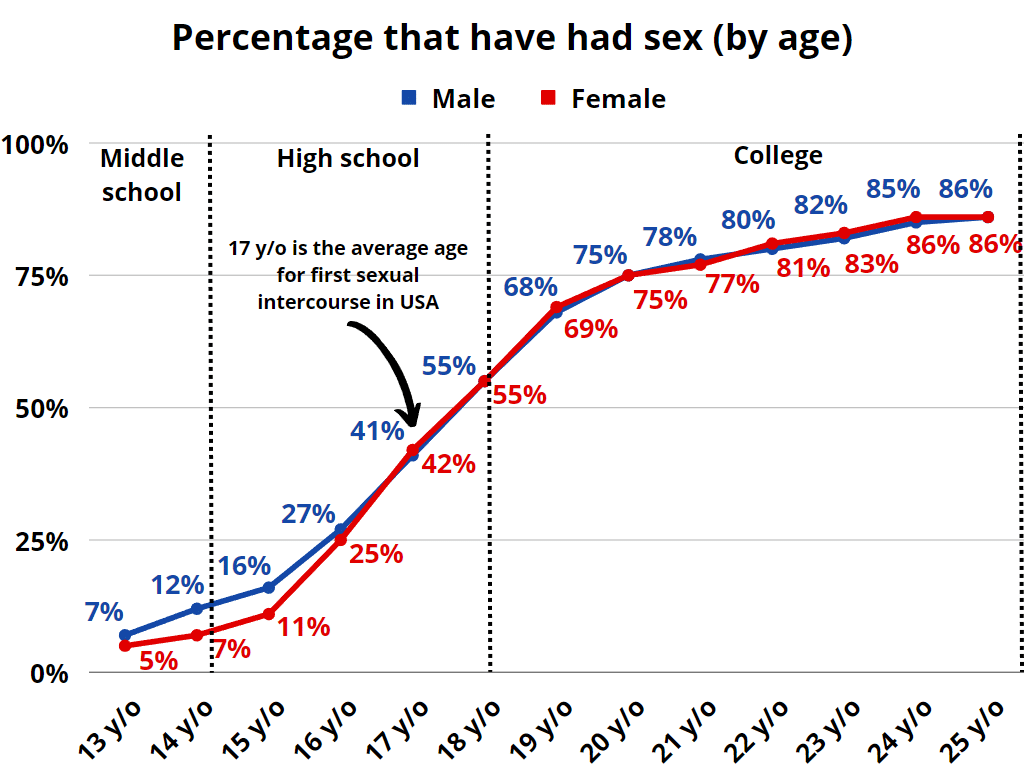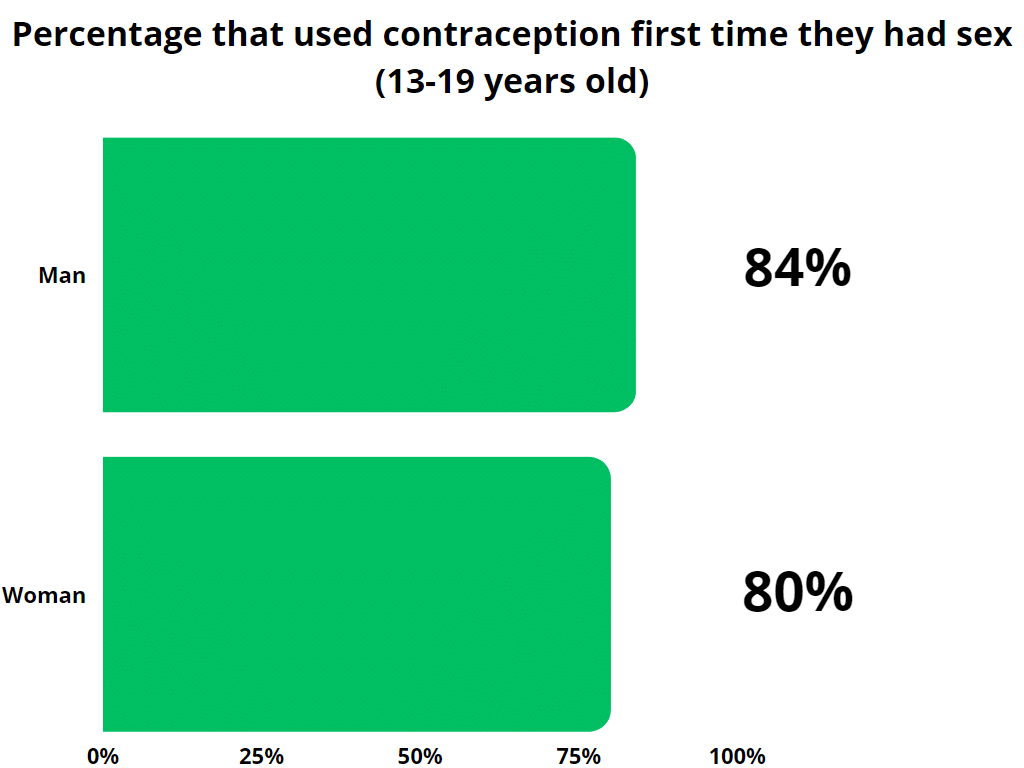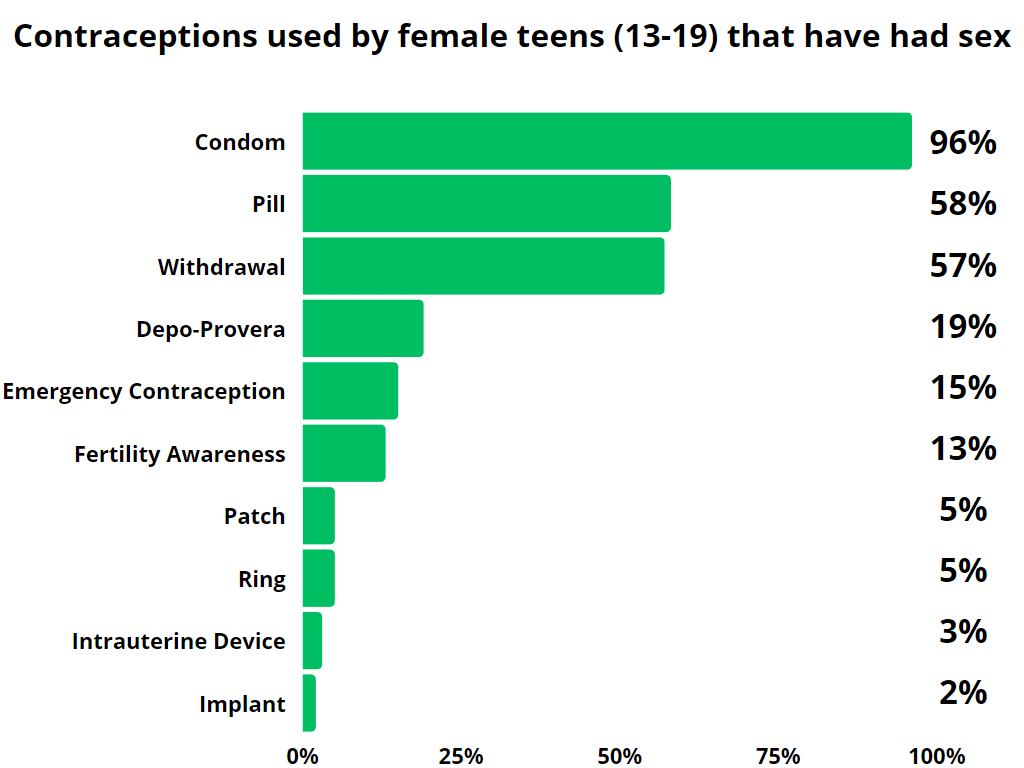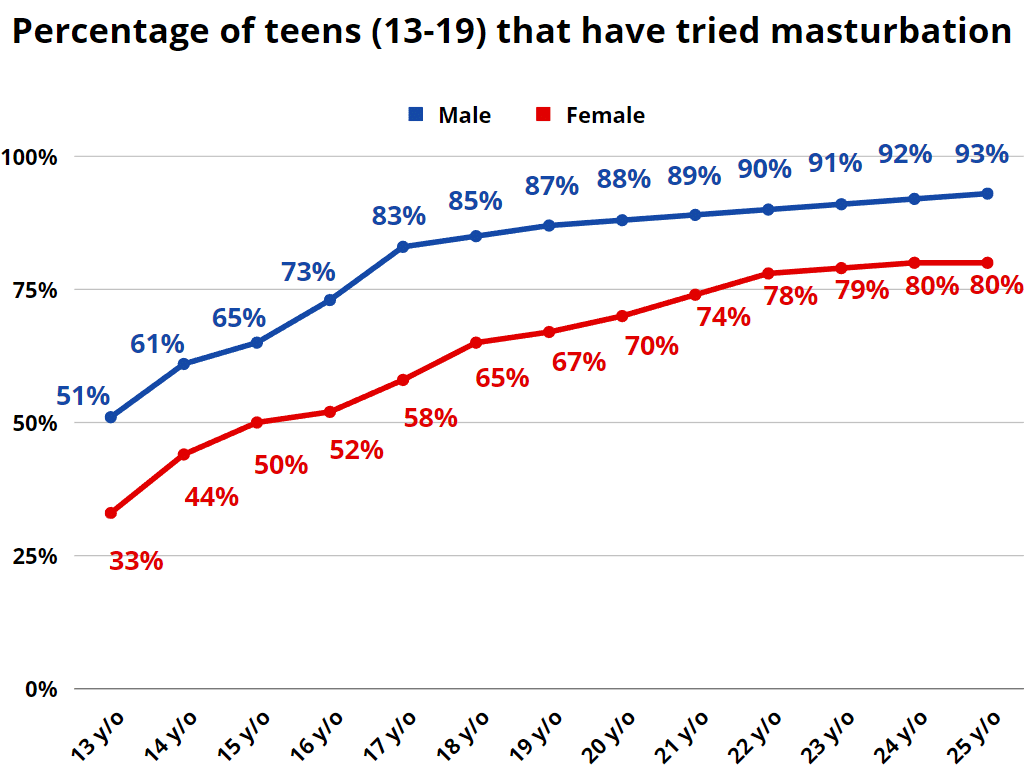![Teenage Sexual Statistics [9,723 Teen Survey]](https://wp.bedbible.com/wp-content/uploads/2023/04/Teenage-Sexual-Statistics.png)
Curious about the real facts and stats on teenage sexuality? Then you’ve ended up in the right place because we’ve got the scoop for you! Our report on teenage sexuality statistics and teen sex statistics is based on a survey of a whopping 9,723 American teens.
We’re uncovering the good, the bad, and the unexpected about their relationships, sex education, and sexual health, all backed by solid data. No need to tiptoe around the sensitive stuff; we’re diving right in with hard-hitting statistics.
So, if you’re ready to get the inside story of what today’s teens are experiencing, keep reading and prepare to be amazed by our eye-opening findings!
Table of contents:
- Teen Sex Behavior
- Teenage Sexual Assault Statistics
- Sexually Transmitted Diseases (STDs) & Contraception
- Sex Education for Teenagers
- Relationships
- Masturbation
Key Takeaways
- 45% by the age of 18 did not have sex (both females and males in the US).
- For 15-17-year-olds, the percentage of boys who have never had sexual intercourse is 71%, while the percentage of girls is 76%.
- 44% of young individuals aged 15 to 19 have engaged in oral sex with a partner of the opposite sex.
- Less than 10% of teens have tried anal sex.
- 17 y/o is the average age for teens in the US to have their first sexual intercourse.
- 8 out of 10 sexual assault victims are females under 18.
- 8 out of 10 teens used contraception (e.g. condom) the first time they had sex.
- 4 out of 10 sexually active teen girls have contracted at least one sexually transmitted disease (STD).
- Around 4 out of 10 teenagers report feeling pressured to have sex due to their sex education classes.
- Sex education is mandated in 30 states for school curriculum.
- The interest in romantic and sexual contact starts to develop between the ages of 11 to 14.
- 51% of the 13 y/o males have tried masturbating whereas only 33% of females have tried it, and 80% of 25 y/o females have tried masturbating whereas 93% of males have.
Teen Sex Behavior
The behavior of teenagers, when we talk about sexuality, is in general associated with trial and error. The teens try a lot of different things. They are more open to trying new things, and the experience they have with the sexual trial will in most cases influence their opinion towards; anal sex, oral sex, etc. We have listed the most interesting teen sex facts and stats below:
- Over the past 31 years (1991-2022), the percentage of high school students who have never engaged in sexual intercourse has increased by 39%.
- 45% by the age of 18 did not have sex.
- For 15-17-year-olds, the percentage of boys who have never had sexual intercourse is 71%, while the percentage of girls is 76%.
- Among 15-17-year-olds, the percentage of boys who have never had any sexual contact with the opposite sex is 56.1%, and the percentage of girls is 64.9%.
- From 1991 to 2022, the percentage of black teens who have not had sex increased by 245%, with black males showing the most significant increase of 360%.
- In the past 29 years, the percentage of high school females who have chosen to delay sexual activity has increased by 25%, while for males, the percentage has increased by 47%.
- Of all teen births, 81% are to unmarried parents.
- Teen birth rates have decreased by 58% since 1991.
- In recent years, about 34% of pregnancies among 15-19-year-olds end in abortion, down from 52% in 1986.
- Since the peak rate in 1988, teen abortion rates have decreased by 80% and are at their lowest point since abortion was legalized.
- The top reasons for teens who had not yet engaged in sexual activity were reported as
- It goes against their religion or morals (6%)
- They haven’t found the right person yet (52%)
- Not wanting to impregnate their partner (in the case of females) (12%)
- The ages of 13 to 19 showed a decrease in solo masturbation, partnered masturbation, oral sex, and anal and vaginal intercourse when compared to the rest of the population.
- Roughly 44% of young individuals aged 15 to 19 have engaged in oral sex with a partner of the opposite sex.
- Less than 10% of teens have tried anal sex.
- For young women between the ages of 15 to 19, approximately 15% have had a sexual experience with a partner of the same sex. Of men, it is only 3% that only same-sex experience.
- Teenagers between the ages of 14 to 19 who have had sexual experiences are likely to report having had three or more sexual partners throughout their lifetime. Just under half of the females (45%) and slightly over half of the males (55%) have had three or more partners.
- 5 out of 10 of 18- and 19-year-olds express regret about not waiting longer before engaging in sexual activity.
- Delaying sexual activity and limiting the number of lifetime sexual partners is crucial in reducing the risk of both pregnancy and sexually transmitted diseases (STDs).
- 17 y/o is the average age for teens in the US to have their first sexual intercourse.

Teenage Sexual Assault Statistics
As a teenager, you’re more exposed to sexual assaults. Simply because you’re an easier victim than elder people. Worth mentioning is that this trend is decreasing which means fewer and fewer teens experience sexual assaults. But but but … there is still a significant amount that does:
- Approximately 13% of girls and 3% of boys under the age of 19 are victims of sexual abuse or assault committed by an adult.
- 8 out of 10 victims under 18 are females.
Sexually Transmitted Diseases (STDs) & Contraception
STDs and contraceptives are part of the sex education that teenagers get in school. And like any other information, the ones we get in elementary school, middle school, and high school typically stick in the mind for a lot of years. So many states within the US see this area as super important to educate about. We’ve checked with young US citizens whether they use contraception, and what the general sentiments are about it:
- 8 out of 10 teens used contraception (e.g. condom) the first time they had sex.
- Of all the contraception methods used by sexually active high school students, only 66% used a condom during their last sexual encounter, which is the only method that also reduces the risk of STDs.
- The likelihood of sexually active high school students using a condom in 2022 is 22% lower than it was in 2007.
- Studies show that the longer a teen delays sexual activity, the more likely they are to use contraception, providing an additional reason to promote sexual delay.
- Although more sexually active high schoolers are using long-acting reversible contraception (LARC), they are failing to use a condom to reduce the risk of STDs.
- The condom was the most frequently used method among teens from 2011 to 2015, with 98% of teen females reporting its use. Withdrawal was the second most commonly used method (54%), followed by the pill (48%).
- Of teens and youth that use condoms the following data applies:
- 7 out of 10 teens did not squeeze the tip of the condom.
- 3 out of 10 teens did not put the condom on the whole penis.
- 5 out of 100 experienced that the condom failed.
- In males between the ages of 13 to 19, 93% of HIV diagnoses were linked to male-to-male sexual contact.
- More than half of all reported cases of chlamydia and gonorrhea are attributed to young adults between the ages of 15 to 24.
- 4 out of 10 sexually active teen girls have contracted at least one sexually transmitted disease (STD).


Sex Education for Teenagers
Sex education is a natural part of the daily activities in the majority of schools in the US. But how many states have sex education, which states, and what do the parents think about it? We’ve answered all these questions below.
- Around 4 out of 10 teenagers report feeling pressured to have sex due to their sex education classes, while 32% state that they feel pressure from their dating partner.
- Over 80% of parents, particularly women and African Americans, express support for the main themes of SRA (Sexual Risk Avoidance) education.
- Sex education is mandated in 30 states for school curriculum.
- In 39 states, sex education is required to include information about Sexual Risk Avoidance (SRA), and in 20 states, information about contraception is also required.
- 35 states and the District of Columbia require the provision of information about skills for healthy romantic and sexual relationships.
- 37 states and the District of Columbia require the provision of information on preventing, recognizing, and responding to teen dating violence and sexual violence.
- HIV/AIDS prevention education is mandated in 39 states for school curricula.
- 25 states require parental notification before sex education classes for their children.
- Parents are permitted to opt out of sex education classes for their children in 36 states.
- In five states, parents are required to opt-in to sex education classes for their children.
- 19 states and the District of Columbia require the inclusion of information on the negative outcomes of teen sex and pregnancy.
| State | Requires Sex Education? |
|---|---|
| Alabama | No |
| Alaska | Yes |
| Arizona | No |
| Arkansas | No |
| California | Yes |
| Colorado | Yes |
| Connecticut | Yes |
| Delaware | Yes |
| Florida | No |
| Georgia | No |
| Hawaii | Yes |
| Idaho | No |
| Illinois | Yes |
| Indiana | No |
| Iowa | Yes |
| Kansas | No |
| Kentucky | No |
| Louisiana | No |
| Maine | Yes |
| Maryland | Yes |
| Massachusetts | Yes |
| Michigan | No |
| Minnesota | Yes |
| Mississippi | No |
| Missouri | No |
| Montana | No |
| Nebraska | No |
| Nevada | Yes |
| New Hampshire | Yes |
| New Jersey | Yes |
| New Mexico | Yes |
| New York | Yes |
| North Carolina | No |
| North Dakota | No |
| Ohio | No |
| Oklahoma | No |
| Oregon | Yes |
| Pennsylvania | No |
| Rhode Island | Yes |
| South Carolina | No |
| South Dakota | No |
| Tennessee | No |
| Texas | No |
| Utah | No |
| Vermont | Yes |
| Virginia | No |
| Washington | Yes |
| West Virginia | No |
| Wisconsin | Yes |
| Wyoming | No |
Relationships
Teenagers’ first sexual intercourse typically happens with a partner. This is primarily because this is considered “safe ground”. But how many have a so-called “one-night stand” with a person they’ve recently met? And, when do teens/youth get interested in having sex with each other? Check the statistics below and you’ll get the facts right away.
- The majority of teens had their first sexual intercourse with a partner they were “committed or exclusive relationship” with (female teens: 68%; male teens: 44%), while a small percentage had their first sexual encounter with someone they had “recently met” (female teens: 3%; male teens: 11%).
- 33% of 13-year-olds have been in a romantic relationship, which may or may not include sexual activity. When 17 years old it increases to 70%.
- The interest in romantic and sexual contact starts to develop between the ages of 11 to 14.
Masturbation
This is often the first sexual activity that a person experiences both for females as well as men. But how many have tried it? And when. We’ve conducted a detailed graph (never seen before) that shows the age of teens when they first try masturbation. Click here if you want to read our in-depth masturbation statistics.
- 51% of the 13 y/o males have tried masturbating whereas only 33% of females have tried it.
- 80% of 25 y/o females have tried masturbating whereas 93% of males have.

Data and Methodology
The people who answered the survey were teenagers/youth between 13 and 25 years old from the United States. We used a simple method to pick participants for the survey, making sure that different types of teenagers were fairly represented in the study. The reports dataset had 9,723 people.
Data collection
The data was gathered through an online survey, which was sent out via social media and school networks. The survey consisted of multiple-choice, and open-ended questions to capture a wide range of information related to teenage sexual behaviors, experiences, and education. To secure honest and accurate responses, participants were assured of the confidentiality of their responses.
Data analysis
Descriptive statistics were used to analyze and summarize data.
Limitations
The study used information given by people themselves, which might not always be accurate because they want to look good or don’t remember well. Also, since the topic is sensitive, some may not have shared the truth, so we might not know everything. Finally, the study was done in the U.S., so the results might not apply to teenagers from other places or cultures.
